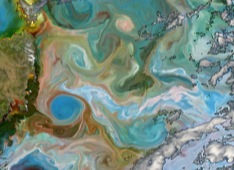
Vortex Dynamics & Non-Equilibrium Statistical Mechanics
CUNY Graduate Center
Science Center: Room 4102
Thursday, March 31, 2011
Schedule:
Morning
9:15 Introduction & Welcome
9:30 Michael Kiessling, Rutgers University
Onsager's point vortex ensembles: 6 decades hence
I review what is rigorously known about Onsager’s ergodic point vortex ensembles and list a number of open
problems which still await a rigorous solution.
10:30 Coffee Break
11:45 David Dritschel, University Saint Andrews
Late time evolution of unforced inviscid two-dimensional turbulence
One of the most intriguing, challenging and beguiling problems in fluid dynamics is turbulence. It is a `problem'
for engineers designing airplanes and for mathematicians trying to understand the behavior of the governing
partial differential equations - even in greatly idealized contexts. Turbulence is a natural `state' of fluid
motion at very high Reynolds numbers (when viscosity is in some sense small). It is a state however with little
or no apparent order,forcing one to seek a statistical description and universal relations between scales of motion.
Real turbulence is three-dimensional, and often depends on many important effects not considered in mathematical analyses. While not always evident, such turbulence is widespread in the atmosphere, the oceans, other planetary atmospheres and probably throughout the universe. The general circulation of the Earth's atmosphere and oceans in fact depends vitally on this turbulence. Yet, in geophysical flows, fluid motion including turbulence is profoundly affected by rotation and stratification, which act to suppress vertical motions in favor of horizontal ones. This gives rise to`layerwise-two-dimensionality', in which fluid flows predominantly along nearly-horizontal stratification surfaces (e.g. isentropic surfaces in the atmosphere and density surfaces in the oceans). Hence, of relevance to geophysical fluid dynamics is layerwise two-dimensional turbulence. In such turbulence, vortex stretching effects are greatly suppressed leading to less extreme behavior. In many of the models commonly studied, one may say in fact that the fluid motion is benign (singularities are ruled out). The simplest and most extensively studied model is two-dimensional turbulence, applicable in a particular limit of the geophysical fluid dynamical equations.
This talk reviews this (controversial) model, first in the absence of forcing, and moreover discusses its inviscid limit, which is aptly called `freely-evolving' rather than `freely-decaying'. Here,vortices play a crucial role by organizing the entire evolution of turbulence, from the smallest to the largest scales. This talk concludes by highlighting several extensions of this research to more realistic models, which are presently foci of intense research.
Afternoon
12:00 Lunch
1:30 Jeffrey Weiss, University of Colorado
Nonequilibrium Statistical Mechanics and Climate Variability
The natural variability of climate phenomena has significant human impacts but is difficult to model and
predict. Natural climate variability self-organizes into well-defined patterns that are poorly understood.
Recent theoretical developments in nonequilibrium statistical mechanics cover a class of simple
stochastic models that are used to model climate phenomena: linear Gaussian models which have
linear deterministic dynamics and additive Gaussian white noise. The theory for nonequilibrium
entropy production is developed for linear Gaussian models and applied to observed tropical sea
surface temperatures (SST). The results show that tropical SST variability is approximately consistent with
fluctuations about a nonequilibrium steady-state.
Thermodynamically small systems in nonequilibrium steady-states have fluctuations which, for a finite
time, reduce the entropy of the system.This is consistent with the Second Law of Thermodynamics which only says that for long times, the entropy must increase. Tropical SST dynamics on seasonal
timescales exhibits entropy reducing fluctuations, indicating that seasonal tropical SST dynamics is small
and fast in a thermodynamic sense. This work demonstrates that nonequilibrium statistical mechanics
can address climate-scale phenomena and suggests that other climate phenomena could be similarly addressed by nonequilibrium statistical mechanics.